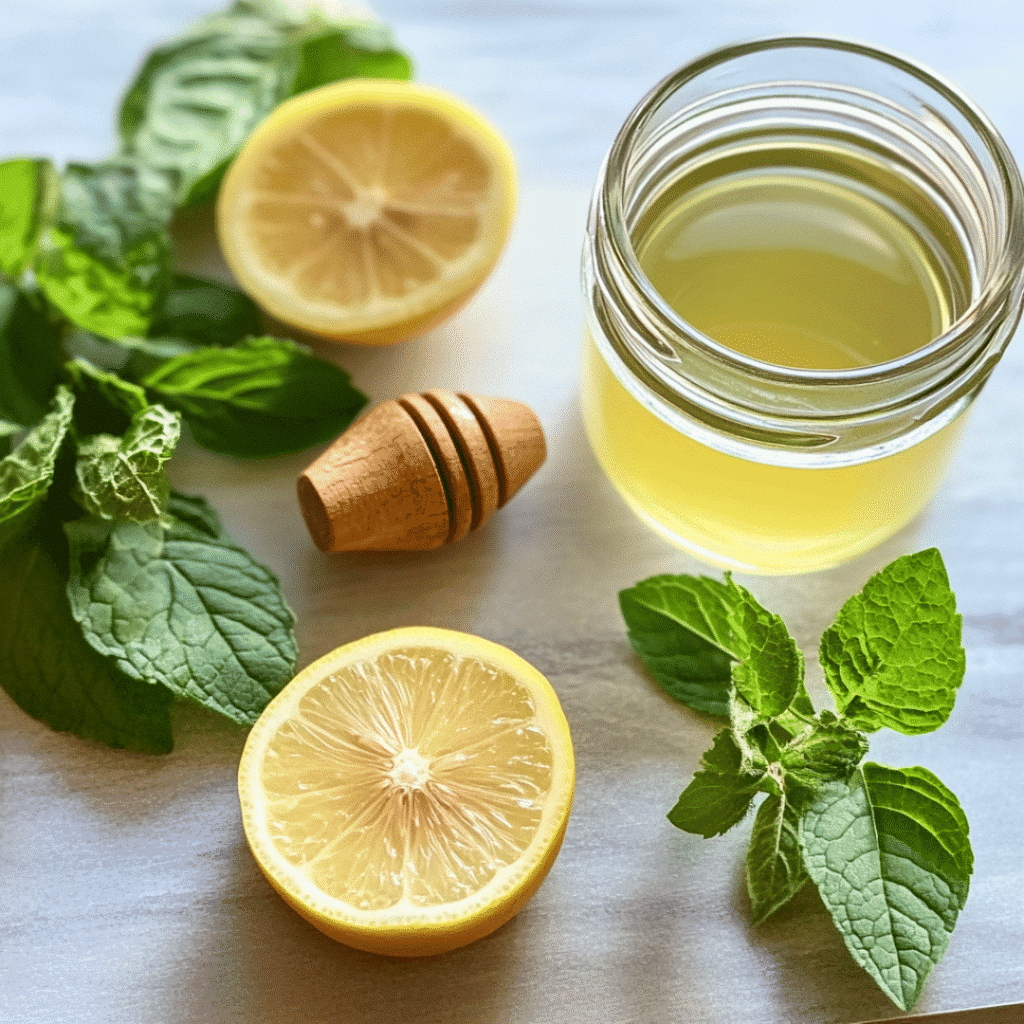Lemon Balm Recipe for Weight Loss: Natural Detox Tea That Works
When it comes to shedding pounds without sacrificing comfort or flavor, a lemon balm recipe might just be your new secret weapon. This article dives deep into how this calming herb not only soothes your nerves but supports real, lasting weight loss. We’ll cover my personal journey, the best way to brew lemon balm, how often to drink it, and tips to maximize its effect. If you’re searching for a natural and delicious way to support your goals, this one’s for you.
My Herbal Journey with Lemon Balm Recipe
From the Deli to Detox: My First Encounter with Lemon Balm Recipe
Hey there—I’m Enzo, and if there’s one thing I’ve learned over the years, it’s that a little patience and a perfectly heated water bath can work miracles in the kitchen. I grew up in Chicago, raised on Italian comfort food and American hustle, and somewhere between my parents’ corner deli and a few wild nights behind a bar, I discovered the beauty of simple herbs.
It was after one of those long weeks—where nothing seemed to work, and the scale was stuck—that I stumbled on lemon balm. My first batch? Just a handful of fresh leaves, steeped gently. It was smooth, bright, and surprisingly satisfying. More importantly, it helped with the bloating that was making me miserable. That moment changed how I approached weight loss.
Why Lemon Balm Recipe Is a Weight Loss Game-Changer
The keyword lemon balm recipe isn’t just trendy—it’s smart. Lemon balm, also known as Melissa officinalis, is part of the mint family. It’s famous for calming stress (which can be a major weight-loss blocker) and gently aiding digestion. When used correctly, this herb works in harmony with your system—not against it.
In my experience, this is where weight loss begins to feel sustainable. No harsh detoxes. No extremes. Just a lemon balm tea recipe that tastes great and helps your body let go of what it doesn’t need. Add this herb into your weight loss plan, and you’ll notice fewer cravings, less bloating, and a more peaceful headspace.
This isn’t magic—it’s just how nature works when you give it the time. And if you’ve ever struggled with late-night snacks or sluggish digestion, pairing this tea with something like my natural Zepbound recipe or hot buttered prune juice detox will take things even further.
Table of Contents
How Lemon Balm Recipe Supports Weight Loss
Lemon Balm Recipe Benefits Backed by Science
It’s easy to write off herbs as old wives’ tales—until you realize lemon balm has some serious science behind it. This soothing green herb contains rosmarinic acid, a compound that’s been studied for its anti-inflammatory and anti-anxiety properties. Why does that matter for weight loss? Because chronic stress spikes cortisol, and cortisol can lead to stubborn belly fat.
By sipping a well-timed lemon balm recipe, especially in tea form, you’re calming your nervous system, easing digestion, and improving your sleep. Each of those factors plays a big role in natural weight regulation. And for those dealing with late-night cravings or emotional snacking, the calming effect of lemon balm can break the cycle.
In a 2021 clinical review, lemon balm was shown to support better mood and reduce mild symptoms of anxiety. That’s no small thing when stress-eating has been your biggest enemy. This is where I tell folks to think long-term: swap your afternoon soda or evening wine for a warm cup of lemon balm tea. You’ll sleep better, snack less, and feel fuller with fewer calories.
How It Helps Reduce Bloating, Cravings & Stress
Another major benefit of lemon balm? It gently reduces bloating. I noticed it right away after a big pasta night—lemon balm helped everything settle faster without the heaviness. It’s especially useful after a protein-rich meal or recipes like keto cottage cheese bagels that are great for weight loss but can be tough on digestion.
It also seems to reset the nervous system in a way that makes healthy eating easier. Less stress means fewer carb cravings. Less bloat means your gut works better. And that calm focus? It’s a game-changer when you’re tracking macros or trying to stay consistent on a plan like my bariatric seed tea users follow.
Want to go even further? Some readers love pairing lemon balm tea with protein bagels made with Greek yogurt for a power-packed, gut-friendly breakfast.
If you’re serious about resetting your metabolism in a gentle and sustainable way, the right lemon balm recipe for weight loss can absolutely be the first step.
Best Lemon Balm Recipe for Weight Loss
Simple Lemon Balm Detox Tea Recipe
This lemon balm recipe is my go-to detox tea. It’s light, slightly citrusy, and delivers exactly what your body needs without caffeine or additives. It works great as a mid-morning digestive reset or an evening wind-down that fights late-night cravings.
Ingredients:
- 1 tablespoon fresh lemon balm leaves (or 1.5 tsp dried)
- 1 slice fresh lemon (optional, but enhances digestion)
- 1 teaspoon raw honey (optional, skip if fasting)
- 1½ cups filtered water
Instructions:
- Bring water to a gentle boil, then remove from heat.
- Add lemon balm leaves and lemon slice. Cover and steep for 8–10 minutes.
- Strain and pour into a mug. Stir in honey if desired.
That’s it. Just pure herbal goodness. For best results, drink this lemon balm recipe warm (not hot), so your body absorbs the calming compounds more easily.
Pairing this tea with a high-protein snack like these cottage cheese bagels with almond flour can support stable blood sugar and keep you satisfied longer.
When and How to Drink It for Results
Timing matters. Based on my personal results and what I’ve seen with readers, here’s how to use lemon balm tea to support weight loss most effectively:
- Morning: Drink a cup on an empty stomach. It gently awakens digestion and reduces cortisol.
- Afternoon: A great alternative to sugary lattes or sodas. Keeps energy steady without the crash.
- Evening (1 hour before bed): Promotes restful sleep and minimizes late-night cravings.
Here’s the key: stay consistent. Drink this tea at least once per day for 2–3 weeks. That’s when bloating eases up, and the appetite-regulating effects start to kick in. Combine that with a low-carb recipe like my Japanese Mounjaro weight support meal and you’re stacking success.
It’s not about chasing trends. It’s about building habits that feel good, taste good, and work with your body—not against it.

Expert Advice & Tips for Using Lemon Balm Safely
Who Should (and Shouldn’t) Use Lemon Balm
While this lemon balm recipe is generally safe, it’s not for everyone. Pregnant or breastfeeding women should consult their doctor before using it regularly. Those with thyroid conditions, especially hypothyroidism, may want to avoid frequent use, since lemon balm can affect thyroid hormone levels.
If you’re on sedatives or medications for anxiety or sleep, lemon balm may amplify those effects. It’s always best to start with a small dose—just one cup a day—and watch how your body responds.
For most, though, it’s a low-risk, high-reward herb. You’ll find it pairs well with other weight-supportive teas like bariatric seed blends or mineral-focused mixes like my Himalayan salt detox infusion.
Additional Natural Remedies That Pair Well
One thing I always recommend when using lemon balm for weight loss is pairing it with foods or supplements that won’t undo its benefits. Avoid sugary snacks or late-night meals that spike insulin.
Instead, try combining this tea with lean proteins and high-fiber meals. Use cottage cheese recipes with minimal flour or egg-based dishes. For natural appetite support, pair lemon balm with magnesium-rich snacks or a small handful of almonds in the evening.
Want more synergy? Try this lemon balm tea after meals with fermented foods like sauerkraut, or a probiotic-rich yogurt bowl. Better digestion = better results.
FAQs About Lemon Balm Recipe
Can lemon balm really help with weight loss?
Yes. Lemon balm supports weight loss by easing bloating, reducing cortisol, and curbing cravings, especially when consumed consistently as tea.
How often should I drink lemon balm tea?
1–2 times daily is ideal. Morning and evening use are the most beneficial for digestion and appetite control.
What’s the best time of day to drink lemon balm tea?
Evenings are best if you struggle with stress eating. Mornings are helpful to reduce cortisol and set digestion right for the day.
Can I grow my own lemon balm for recipes?
Absolutely! Lemon balm grows easily in containers or gardens and thrives with sunlight and regular trimming. Just be sure to use fresh leaves for the most flavor.
Conclusion
Lemon balm recipe isn’t just another herbal hype—it’s a smart, gentle aid for anyone looking to lose weight naturally. Whether you’re starting your health journey or fine-tuning what already works, this lemon balm recipe can make a real difference.
Its stress-reducing, digestion-soothing effects go beyond temporary fixes. With consistent use, you’ll likely notice reduced bloating, better sleep, fewer cravings, and a calmer relationship with food.
Backed by research like this NIH study, lemon balm proves that nature knows what it’s doing. Want even more depth? Check out research on its anti-anxiety properties from Mount Sinai or explore the detailed plant chemistry via WebMD.
Give it time, give it love, and lemon balm just might return the favor in full.
Print
Lemon Balm Recipe for Weight Loss: Natural Detox Tea That Works
- Total Time: 12 min
- Yield: 1 cup 1x
- Diet: Gluten Free
Description
This lemon balm recipe is a soothing, herbal detox tea that supports weight loss by calming stress, reducing bloating, and curbing appetite.
Ingredients
1 tbsp fresh lemon balm (or 1.5 tsp dried)
1 slice fresh lemonn1 tsp raw honey (optional)
1.5 cups filtered water
Instructions
Bring water to a gentle boil and remove from heat.
Add lemon balm and lemon slice. Cover and steep for 8–10 minutes.
Strain and pour into mug. Add honey if desired.
Notes
Use fresh lemon balm for best results.
Drink warm, not hot.
Avoid during pregnancy or thyroid conditions without doctor advice.
- Prep Time: 2 min
- Cook Time: 10 min
- Category: Beverage
- Method: Infusion
- Cuisine: Herbal/Natural
Nutrition
- Serving Size: 1 cup
- Calories: 15
- Sugar: 3g
- Sodium: 2mg
- Fat: 0g
- Saturated Fat: 0g
- Unsaturated Fat: 0g
- Trans Fat: 0g
- Carbohydrates: 4g
- Fiber: 0g
- Protein: 0g
- Cholesterol: 0mg
Printable Recipe Card
Want just the essential recipe details without scrolling through the article? Get our printable recipe card with just the ingredients and instructions.









you’re in point oof fact a just right webmaster. The website loading pace is incredible.
It kind off feels that you are doing any distinctive trick.
Furthermore, The contents are masterpiece. you’ve done a great proces on this matter!